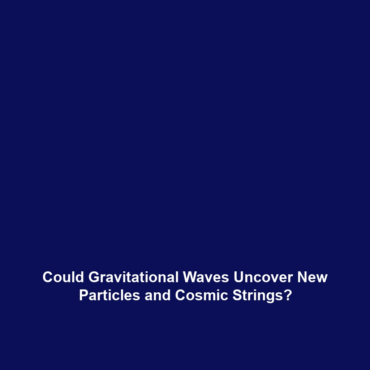Could Gravitational Waves Help Detect New Particles or Phenomena Like Cosmic Strings?
Introduction
Gravitational waves, ripples in spacetime caused by the acceleration of massive objects, offer a revolutionary tool in astrophysics and particle physics. The potential of detecting new particles or phenomena, such as cosmic strings—hypothetical one-dimensional defects in spacetime—adds another layer of significance to gravitational wave research. Scientists are increasingly exploring whether these waves can uncover unknown aspects of our universe, including entities that conventional particle physics might overlook. Understanding this relationship is crucial for advancing the study of both gravitational waves and the underlying fabric of cosmos.
Key Concepts
Gravitational Waves
Gravitational waves are produced by catastrophic astrophysical events, such as black hole mergers or neutron star collisions. They propagate at the speed of light and are detectable by advanced observatories like LIGO and Virgo. The study of these waves not only enhances our understanding of general relativity but also of fundamental particle interactions in the universe.
Cosmic Strings
Cosmic strings are theorized to be remnants from the early universe, potentially formed during phase transitions. These defects could have enormous mass concentrated in thin filaments and might influence cosmological structure formation. Many physicists are optimistic that gravitational waves could directly provide evidence of cosmic strings and provide insights into their characteristics.
Applications and Real-World Uses
The exploration of how gravitational waves are used in detecting new particles is paramount in advancing both theoretical astroparticle physics and experimental avenues. Some significant applications include:
- Identifying signatures of cosmic strings through their distinct gravitational wave patterns.
- Enhancing models of the early universe by correlating gravitational wave observations with cosmic string predictions.
- Integrating gravitational wave data with particle collider experiments for a comprehensive particle physics landscape.
Current Challenges
The road ahead for utilizing gravitational waves to detect cosmic strings is fraught with challenges:
- Signal Detection: The sensitivity required to detect potential cosmic string signals against background noise is an ongoing challenge.
- Model Limitations: Current theoretical models may not adequately predict the gravitational wave signatures emitted by cosmic strings.
- Data Analysis: Advanced data processing techniques are essential to sift through the massive datasets generated by detectors.
Future Research and Innovations
Future research in the realm of gravitational waves promises exciting possibilities. Innovations such as next-generation detectors (like Einstein Telescope and Cosmic Explorer) are being developed to achieve higher sensitivity. These upgrades will be pivotal in refining our ability to detect subtle signals from cosmic strings and potentially uncover new particles. Collaborations between gravitational wave astrophysics and particle physics communities could also lead to groundbreaking discoveries.
Conclusion
The investigation into whether gravitational waves can help detect new particles or phenomena like cosmic strings is at the forefront of modern astrophysics. As we enhance our observational capabilities and theoretical frameworks, the potential for significant discoveries may redefine our understanding of the universe. For those eager to engage in this field, subscribing to scientific journals and following advancements in gravitational wave research can provide valuable insights.
For further reading, check out our articles on gravitational waves and particle physics.

Leave a Reply